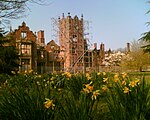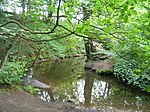St Mary's Church, Tarleton
1525 establishments in England18th-century Church of England church buildingsChurch of England church buildings in LancashireChurches completed in 1719Churches completed in 1824 ... and 4 more
Churches in the Borough of West LancashireChurches preserved by the Churches Conservation TrustGeorgian architecture in EnglandGrade II* listed churches in Lancashire

St Mary's Church is a redundant Anglican church on the A59 road as it passes to the south of the village of Tarleton, Lancashire, England. It is recorded in the National Heritage List for England as a designated Grade II* listed building, and is under the care of the Churches Conservation Trust. It is described by the Churches Conservation Trust as a "picturesque early Georgian chapel" with "a lovely unspoiled interior".
Excerpt from the Wikipedia article St Mary's Church, Tarleton (License: CC BY-SA 3.0, Authors, Images).St Mary's Church, Tarleton
Bank Bridge, West Lancashire Tarleton
Geographical coordinates (GPS) Address Website Nearby Places Show on map
Geographical coordinates (GPS)
| Latitude | Longitude |
|---|---|
| N 53.6748 ° | E -2.8239 ° |
Address
CHURCH OF ST MARY
Bank Bridge
PR4 6NB West Lancashire, Tarleton
England, United Kingdom
Open on Google Maps







